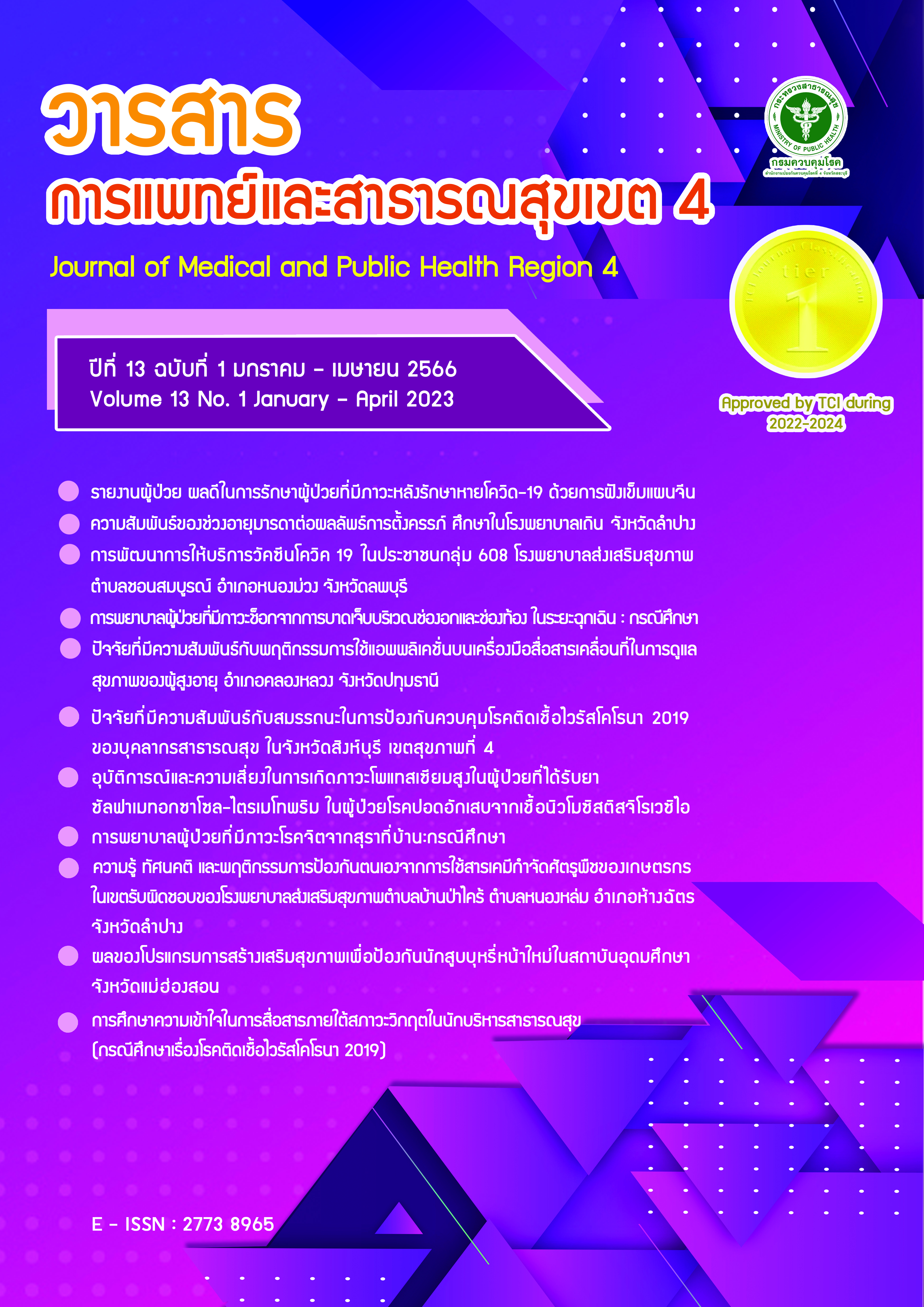The relationship between mother age and pregnancy outcomes in Thoen Hospital, Lampang Province
Main Article Content
Abstract
The goal of this study was to determine the relationship between women's ages and their pregnancy outcomes. A retrospective cohort study examined data from 1,431 pregnant women who gave birth at Thoen Hospital Between 1 October 2017 - 28 February 2022. The women were divided into 4 age groups: < 20 years, 20-29 years, 30-39 years, and 40 years and older. Descriptive statistics such as percentage, mean, standard deviation (SD) and ANOVA, Kruskal-Wallis H Test, Independent T-Test, Mann-Whitney U Test, chi-square test and Fisher's Exact test were used. The study found that pregnant women age < 20 year had a lower rate of caesarean section, hypertension, and gestational diabetes but higher rates of HIV infection and low birth weight than other groups. In addition, this group had poor quality of antenatal care. Pregnant women aged 20-29 years were found to have the lowest rate of low birth weight babies, babies with birth asphyxia, and preterm birth amongst all of the age groups. Pregnant women aged 30-39 years had better access to prenatal care and the mean birth weight of their babies was higher than other groups, however, there were higher number of caesarean sections. In addition, abnormal presentation and macrosomia was found more often in this age group than in the others. Pregnant women aged 40 and older were shown to have the highest rate of pregnancy included hypertension, gestational diabetes, preterm labor, post term labor, and birth asphyxia than other groups. The analysis found that pregnant women aged 20-29 years had good overall pregnancy outcomes in several respects, recommending that pregnancy should be promoted during this age. There are several poor pregnancy outcomes for women aged 40 and older, which are not recommended for pregnancy. However, if a woman does get pregnant in this age group, they should be closely monitored.
Article Details

This work is licensed under a Creative Commons Attribution-NonCommercial-NoDerivatives 4.0 International License.
References
Fretts R.C. Effects of advanced maternal age on pregnancy. In Wilkins–Haug L Eds UptoDate. [Internet]. 2017 [cited 2021 Sep 5]. Available from: https://www.Uptodate.com/contents/effects-of-advanced-maternal-age-on-pregnancy
Fretts R.C. Management of pregnancy in women of advanced age. In Wilkins-Haug, L Eds UptoDate. [Internet]. 2017 [cited 2021 Sep 5]. Available from: https://www.uptodate.com/contents/management-of-pregnancy-in-women-of-advanced-age.
Martin JA, Hamilton BE, Osterman MJK. Births in the United States, 2015. NCHS data brief, no 258. Hyattsville, MD: National Center for Health Statistics. 2016. Available from: https://www.cdc.gov/nchs/data/databriefs/db258.pdf.
Isaraphakdi Ph, Phimnin Th. Quality of Pregnancy Outcomes among Thai Women of Reproductive Age during 1998-2015. In Suchada Taweesit and Kulpa Wajanasara (Editors). Population and society, 2560. Available from: http://www.ms.ipsr.mahidol.ac.th/Conference2017/Download/Book/05_Pimonpan-Quality%20of%20pregnancy.pdf (in Thai)
World Health Organization . Adolescent Pregnancy (Issues in Adolescent health and Development). Geneva: World Health Organization; 2004.
World Health Organization. Pregnant adolescent: delivering on global promise of hope. Geneva: World Health Organization; 2006.
Solomon-Fears C. Teenage Pregnancy Prevention: Statistic and Programs, Congressional Research Service, April 2012, 1-3.
public health commission Senate. Report on the study on the problem of adolescent pregnancy. Senate; 2011 February 7.
Ministry of Public Health. National Reproductive Health Development Policy and Strategy, 1st Edition (2010-2014). National Reproductive Health Development Board, 1st time/2010;2010 April 28.
Usta IM, Zoorob D, Abu-Musa A, Naassan G, Nassar AH. Obstetric outcome of teenage pregnancies compared with adult pregnancies. Acta Obstet Gynecol Scand 2008;87(2):178-83.
Lao TT, Ho LF. Obstetric outcome of teenage pregnancies. Hum Reprod 1998 Nov;13(11):3228-32.
Luke B, Brown MB. Elevated risks of pregnancy complications and adverse outcomes with increasing maternal age. Hum Reprod 2007;22:1264.
Greenberg MB, Cheng YW, Sullivan M, Norton ME, Hopkins LM, Caughey AB. Does length of labor vary by maternal age? Am J Obstet Gynecol 2007;197(4):428.
McLennan AS, Gyamfi-Bannerman C, Ananth CV, Wright JD, Siddiq Z, D'Alton ME, et al. The role of maternal age in twin pregnancy outcomes. Am J Obstet Gynecol 2017 Jul;217(1):80.
Fox NS, Rebarber A, Dunham SM, Saltzman DH. Outcomes of multiple gestations with advanced maternal age. J Matern Fetal Neonatal Med 2009 Jul;22(7):593-6.
Briggs MM, Hopman WM, Jamieson MA. Comparing pregnancy in adolescents and adults: obstetric outcomes and prevalence of anemia. J Obstet Gynaecol Can 2007 Jul;29(7):546-55.
Fraser AM, Brockert JE, Ward RH. Association of young maternal age with adverse reproductive outcomes. N Engl J Med 1995;332:1113-7.
Khashan AS, Baker PN, Kenny LC. Preterm birth and reduced birthweight in first and second teenage pregnancies: a register-based cohort study. BMC Pregnancy Childbirth 2010;10:36-43.
Suebnukarn K, Phupong V. Pregnancy outcomes in adolescents < or = 15 years old. J Med Assoc Thai 2005;88:1758-62.
Walker KF, Malin G, Wilson P, Thornton JG. Induction of labour versus expectant management at term by subgroups of maternal age: an individual patient data meta-analysis. Eur J Obstet Gynecol Reprod Biol. 2016 Feb;197:1-5.
Scholl TO, Hediger ML, Belsky DH. Prenatal care and maternal health during adolescent pregnancy:a review and meta-analysis. J Adolesc Health 1994;15:444-56.
Kovavisarach E, Chairaj S, Tosang K, Asavapiriyanont S, Chotigeat U. Outcome of teenage pregnancy in Rajavithi hospital. J Med Assoc Thai 2010;93(1):1-8.
Watcharasseranee N, Pinchantra P, Piyawan S. The incidence and complications of teenage pregnancy at Chonburi hospital. J Med Assoc Thai 2006;89(suppl 4):s118-23.
Thato S, Rachukul S, Sopajaree C. Obstetrics and perinatal outcomes of Thai pregnant adolescents: a retrospective study. Int J Nurs Stud 2007;44:1158-64.


